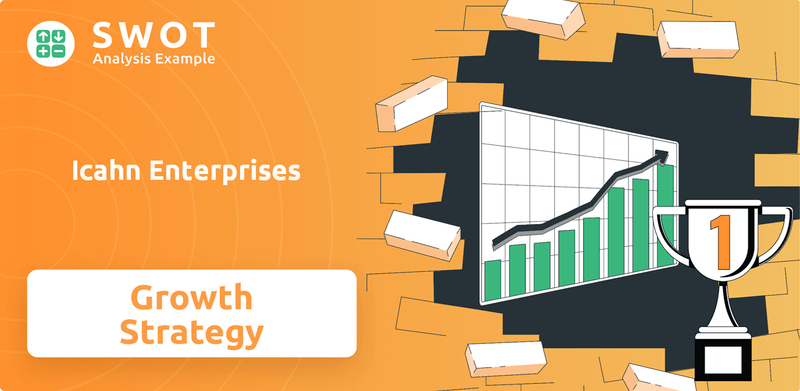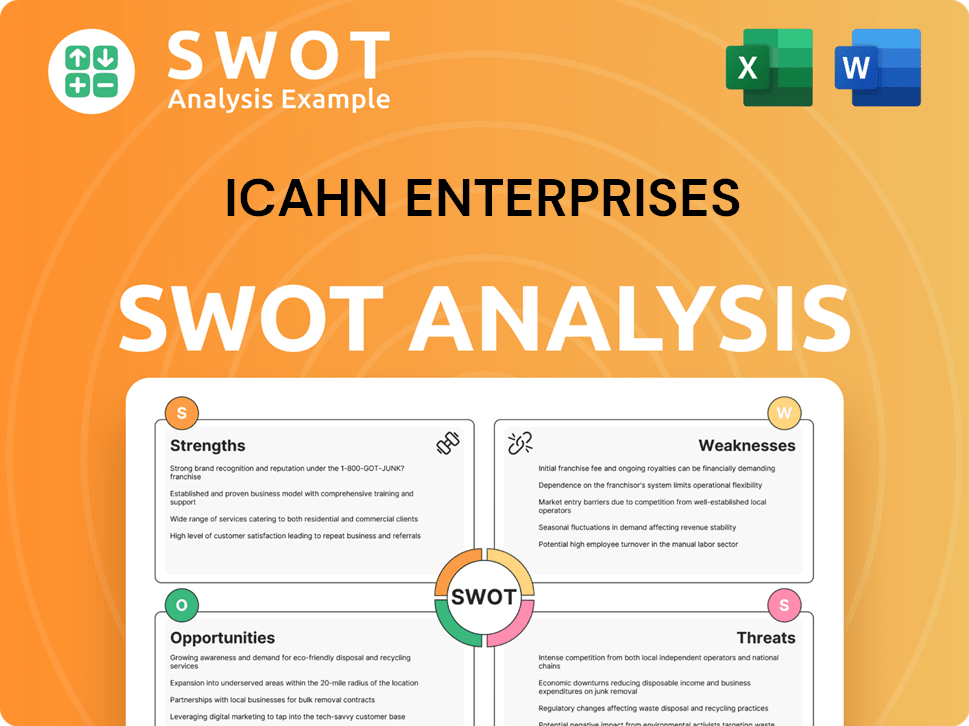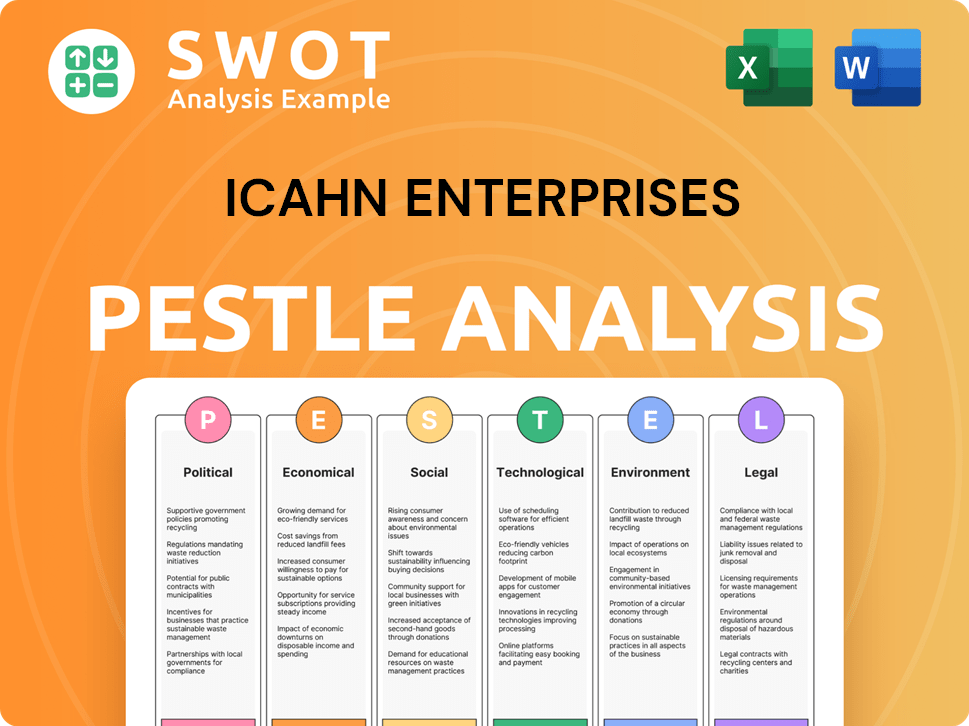Icahn Enterprises Bundle
Can Icahn Enterprises Continue Its Legacy of Value Creation?
Icahn Enterprises, the diversified holding company built on the activist investment principles of Carl Icahn, presents a compelling case study in long-term value creation. From its roots as a brokerage firm in 1968, the company has evolved into a multi-industry conglomerate, navigating market complexities and economic cycles. Its future prospects are intrinsically linked to its ability to adapt and execute its unique Icahn Enterprises SWOT Analysis.

This exploration delves into the intricacies of Icahn Enterprises' growth strategy, examining how it plans to leverage its investment philosophy and diverse portfolio to achieve future success. We will analyze the key drivers of its growth, assess the challenges it faces, and evaluate its potential for long-term value creation, providing insights for investors and business strategists alike. Understanding the evolution of this investment company and its strategic approach is crucial for anyone seeking to understand the dynamics of the financial markets and the impact of a strong business strategy.
How Is Icahn Enterprises Expanding Its Reach?
The expansion initiatives of Icahn Enterprises are primarily driven by its activist investment strategy. This involves acquiring significant stakes in companies and influencing their strategic direction to unlock shareholder value. The company's growth is intrinsically linked to its ability to identify and capitalize on undervalued assets and improve operational efficiency.
While specific plans for entering new geographical markets or launching numerous new products across all segments are not explicitly detailed in recent reports, the company's approach is dynamic. Icahn Enterprises adapts to market opportunities, leveraging its financial resources for potential acquisitions within and outside its existing operating segments. This flexibility is a key component of its strategy.
The company's focus on value creation through strategic interventions and operational improvements is a core element of its growth strategy. This is particularly evident in its approach to restructuring and optimizing its existing businesses, as well as its opportunistic approach to new investments.
The automotive segment is undergoing restructuring, including the closure of underperforming stores. This strategic shift aims to improve long-term profitability. The company is exploring real estate opportunities arising from these closures, seeking to grow in areas of historical strong profitability.
The company has been awarded a contract to operate approximately 15 locations on military bases. This allows for capital-light growth, expanding its footprint within a stable and reliable market. This is a strategic move to secure consistent revenue streams.
The automotive aftermarket parts business is expected to complete its winding down by the end of Q1 2025. This strategic decision allows the company to focus on more profitable ventures. This move is aimed at streamlining operations and improving overall financial performance.
In the pharma segment, the focus is on continued market share and prescription growth for Pancreaze in the U.S. and managing Qsymia's introduction to generic competition in 2025. They have also launched Qsiva into European and Middle Eastern markets, with an emphasis on expanding approved countries. Furthermore, the company is continuing the development of pipeline products and reviewing additional licensing opportunities.
The energy segment is also undergoing strategic transactions, reflecting the company's dynamic approach to its portfolio. The company's investment philosophy also involves taking advantage of market opportunities as they arise, leveraging a 'war chest' of liquidity for potential acquisitions within and outside existing operating segments. This flexibility is a hallmark of the company's approach, allowing it to adapt to changing market conditions and pursue value-creating opportunities.
- The company's ability to identify and capitalize on undervalued assets is crucial to its growth strategy.
- Restructuring underperforming businesses is a key element of improving operational efficiency.
- Strategic transactions and opportunistic acquisitions are central to its investment philosophy.
- The company's financial resources provide flexibility for future investments.
Icahn Enterprises SWOT Analysis
- Complete SWOT Breakdown
- Fully Customizable
- Editable in Excel & Word
- Professional Formatting
- Investor-Ready Format

How Does Icahn Enterprises Invest in Innovation?
The innovation and technology strategy of Icahn Enterprises is primarily driven by its activist investment model. This model focuses on enhancing the value of its diverse portfolio companies through strategic and operational improvements. The company does not have a centralized corporate R&D department for specific technologies.
Instead, technological advancements and innovation are expected to be integrated within the subsidiaries. This approach aims to improve operational efficiencies and strategic changes across various sectors, including automotive, energy, food packaging, and pharmaceuticals. The goal is to boost overall performance and drive sustained growth.
Within its operating segments, subsidiaries are expected to invest in technology to remain competitive. For example, in food packaging, there's a focus on improving plant efficiency, suggesting potential technological upgrades. The home fashion segment has seen improved manufacturing efficiencies, pointing to better processes or technologies. In pharmaceuticals, the company continues developing pipeline products, which inherently relies on innovation in drug discovery and development.
The company's approach involves driving technological adoption and digital transformation within its portfolio companies. This is done to improve performance and unlock value. The focus is on strategic initiatives and corporate governance changes.
- The activist strategy aims to unlock value through strategic initiatives and corporate governance changes within its portfolio companies.
- Subsidiaries are expected to make necessary investments to remain competitive and stimulate growth, which implicitly includes leveraging technology.
- In the pharma segment, the company continues the development of pipeline products and reviews additional licensing opportunities, which inherently relies on innovation and technological advancements.
- A developmental therapy recently cleared a significant FDA milestone, with preparations for clinical trials underway, showcasing a commitment to innovation within that sector.
Icahn Enterprises PESTLE Analysis
- Covers All 6 PESTLE Categories
- No Research Needed – Save Hours of Work
- Built by Experts, Trusted by Consultants
- Instant Download, Ready to Use
- 100% Editable, Fully Customizable

What Is Icahn Enterprises’s Growth Forecast?
The financial outlook for Icahn Enterprises reflects a period of mixed performance and strategic adjustments. The company's recent financial reports indicate significant challenges, particularly in early 2025, alongside strategic initiatives aimed at long-term value creation. Understanding these dynamics is crucial for assessing the Growth Strategy and Future Prospects of this Investment Company.
In the first quarter of 2025, Icahn Enterprises reported a net loss, signaling financial headwinds. Despite these challenges, the company maintains a strong liquidity position, which provides flexibility in navigating market uncertainties and pursuing strategic opportunities. The company's approach involves a mix of addressing immediate financial pressures while positioning itself for future growth.
The company's performance in Q1 2025 showed a net loss of $422 million, or $0.79 per depositary unit, a significant downturn from a net loss of $38 million in Q1 2024. Revenues also decreased to $1.9 billion in Q1 2025 from $2.5 billion in Q1 2024, falling short of expectations. The Adjusted EBITDA swung to a loss of $287 million in Q1 2025, contrasting with a positive $134 million in Q1 2024. These figures highlight the immediate financial pressures faced by the company.
The indicative net asset value decreased by $336 million to approximately $3.0 billion as of March 31, 2025, from December 31, 2024. This decrease reflects the impact of the losses incurred during the first quarter. The company declared a quarterly distribution of $0.50 per depositary unit, payable around June 25, 2025, which is a 50% reduction from the previous year.
Icahn Enterprises is focusing on improvements in its automotive segment sales and profitability, with normalization expected by the second half of 2025. The company is also exploring real estate opportunities and addressing a $438 million RINs litigation. These initiatives are aimed at improving future performance and mitigating existing risks.
The company maintains a strong liquidity position, with total liquidity of $3.8 billion as of Q1 2025. In Q4 2024, the holding company had cash and investments in funds of $4.1 billion. This strong liquidity provides a financial cushion and allows for strategic flexibility. The financial strategy prioritizes building asset value and maintaining liquidity.
Analysts forecast a 16% revenue decline for the current year. This forecast underscores the challenges the company faces and the importance of successful execution of its strategic initiatives. The company's ability to navigate these challenges will be critical to its future performance.
Icahn Enterprises faces several challenges, including the losses in the Investment segment and the overall revenue decline. However, the company also has opportunities, such as the potential for improved performance in the automotive segment and the exploration of real estate opportunities. The company's focus on maintaining liquidity and building asset value is a key part of its Business Strategy.
- The Investment segment's losses, particularly in healthcare, have significantly impacted the company's financial results.
- The anticipated improvements in the automotive segment and potential real estate ventures offer avenues for future growth.
- The company's strong liquidity provides a buffer against economic uncertainties and allows for strategic investments.
- Addressing the $438 million RINs litigation is crucial for financial stability.
For more insights into the ownership structure, you can read about the Owners & Shareholders of Icahn Enterprises.
Icahn Enterprises Business Model Canvas
- Complete 9-Block Business Model Canvas
- Effortlessly Communicate Your Business Strategy
- Investor-Ready BMC Format
- 100% Editable and Customizable
- Clear and Structured Layout

What Risks Could Slow Icahn Enterprises’s Growth?
The path for Icahn Enterprises toward achieving its Growth Strategy and realizing its Future Prospects is fraught with potential risks and obstacles. These challenges span market volatility, industry-specific pressures, and financial sustainability concerns. Understanding these risks is crucial for investors and stakeholders assessing the company's long-term viability.
Market dynamics, including economic downturns and sector-specific issues, significantly impact the investment fund's performance, which is a critical part of the Icahn Enterprises Business Strategy. Furthermore, operational challenges within its diversified segments, such as automotive and energy, add to the complexity. The company's high debt levels and the potential for negative press scrutiny also pose considerable threats to its financial stability and investor confidence.
Carl Icahn, and his Investment Company, must navigate these hurdles to ensure continued growth. The company's strategic responses, including restructuring and focusing on activist investments, are vital to mitigating these risks and driving shareholder value. However, the effectiveness of these strategies remains to be seen.
Market volatility significantly impacts the performance of the investment fund. In Q1 2025, the Investment segment reported losses. The healthcare sector contributed to a $224 million loss in Q1 2025, demonstrating the sensitivity of the company's investments to market fluctuations.
The automotive segment faces restructuring challenges, with a 9% year-over-year sales drop in Q1 2025. The energy segment struggles with fluctuating crack spreads, resulting in a negative EBITDA of $61 million in Q1 2025. These industry-specific issues create operational and financial risks.
Ongoing legal uncertainties, such as the $438 million RINs litigation, pose financial risks. The high debt load and reliance on leverage also create sustainability concerns. These factors can strain the company's resources and impact its financial performance.
Short-seller reports can lead to stock price drops and investor confidence issues. The Hindenburg Research report in May 2023 raised concerns about overvaluation and unsustainable dividends. This scrutiny highlights the importance of transparency and financial health.
A dividend cut, such as the 50% reduction in Q1 2025 from $1.00 to $0.50 per unit, can trigger a decline in stock value. This action reflects the company's efforts to manage its financial resources. It also impacts investor sentiment.
Potential macroeconomic pressures could impact real estate valuations. Economic downturns or shifts in market conditions can affect the value of the company's assets. This can impact the overall financial performance.
Icahn Enterprises is addressing these risks through strategic restructuring, such as the closure of underperforming automotive locations. They are also exploring real estate opportunities to diversify and potentially increase asset values. These initiatives are designed to improve operational efficiency and financial performance.
The company emphasizes maintaining strong liquidity to capitalize on opportunities. The focus on activist investment strategies aims to drive shareholder value. This approach involves actively engaging with companies to improve their performance and create value for investors.
Icahn Enterprises Porter's Five Forces Analysis
- Covers All 5 Competitive Forces in Detail
- Structured for Consultants, Students, and Founders
- 100% Editable in Microsoft Word & Excel
- Instant Digital Download – Use Immediately
- Compatible with Mac & PC – Fully Unlocked

Related Blogs
- What are Mission Vision & Core Values of Icahn Enterprises Company?
- What is Competitive Landscape of Icahn Enterprises Company?
- How Does Icahn Enterprises Company Work?
- What is Sales and Marketing Strategy of Icahn Enterprises Company?
- What is Brief History of Icahn Enterprises Company?
- Who Owns Icahn Enterprises Company?
- What is Customer Demographics and Target Market of Icahn Enterprises Company?
Disclaimer
All information, articles, and product details provided on this website are for general informational and educational purposes only. We do not claim any ownership over, nor do we intend to infringe upon, any trademarks, copyrights, logos, brand names, or other intellectual property mentioned or depicted on this site. Such intellectual property remains the property of its respective owners, and any references here are made solely for identification or informational purposes, without implying any affiliation, endorsement, or partnership.
We make no representations or warranties, express or implied, regarding the accuracy, completeness, or suitability of any content or products presented. Nothing on this website should be construed as legal, tax, investment, financial, medical, or other professional advice. In addition, no part of this site—including articles or product references—constitutes a solicitation, recommendation, endorsement, advertisement, or offer to buy or sell any securities, franchises, or other financial instruments, particularly in jurisdictions where such activity would be unlawful.
All content is of a general nature and may not address the specific circumstances of any individual or entity. It is not a substitute for professional advice or services. Any actions you take based on the information provided here are strictly at your own risk. You accept full responsibility for any decisions or outcomes arising from your use of this website and agree to release us from any liability in connection with your use of, or reliance upon, the content or products found herein.